Abstract
1. A study has been made, in the cat anaesthetized with chloralose, of the effects of antidromic stimulation of dorsal roots L6-S1 on the blood flow through the gastrocnemius muscle. 2. Stimulation of the peripheral ends of the ligated dorsal roots with current pulses of 0.3-0.5 msec duration and at intensities most effective in activating the smaller afferent fibres, for periods of 15-20 sec, produced a 50-60% increase in muscle vascular conductance which was slow in onset and long outlasted the stimulus. 3. This muscle vasodilatation could be evoked in the paralysed animal and was unaffected by guanethidine or atropine. It was, however, greatly reduced or even abolished by the prostaglandin synthetase inhibitors, indomethacin or acetylsalicylic acid, in doses which had no effect on the dilatation produced by a local injection of acetylcholine or the functional hyperaemia induced by muscle contraction. 4. It is concluded that activity in the smaller myelinated or unmyelinated afferent fibres of skeletal muscle produces an increase in muscle blood flow which is mediated, at least in part, by prostaglandins locally synthesized within the muscle.
Full text
PDF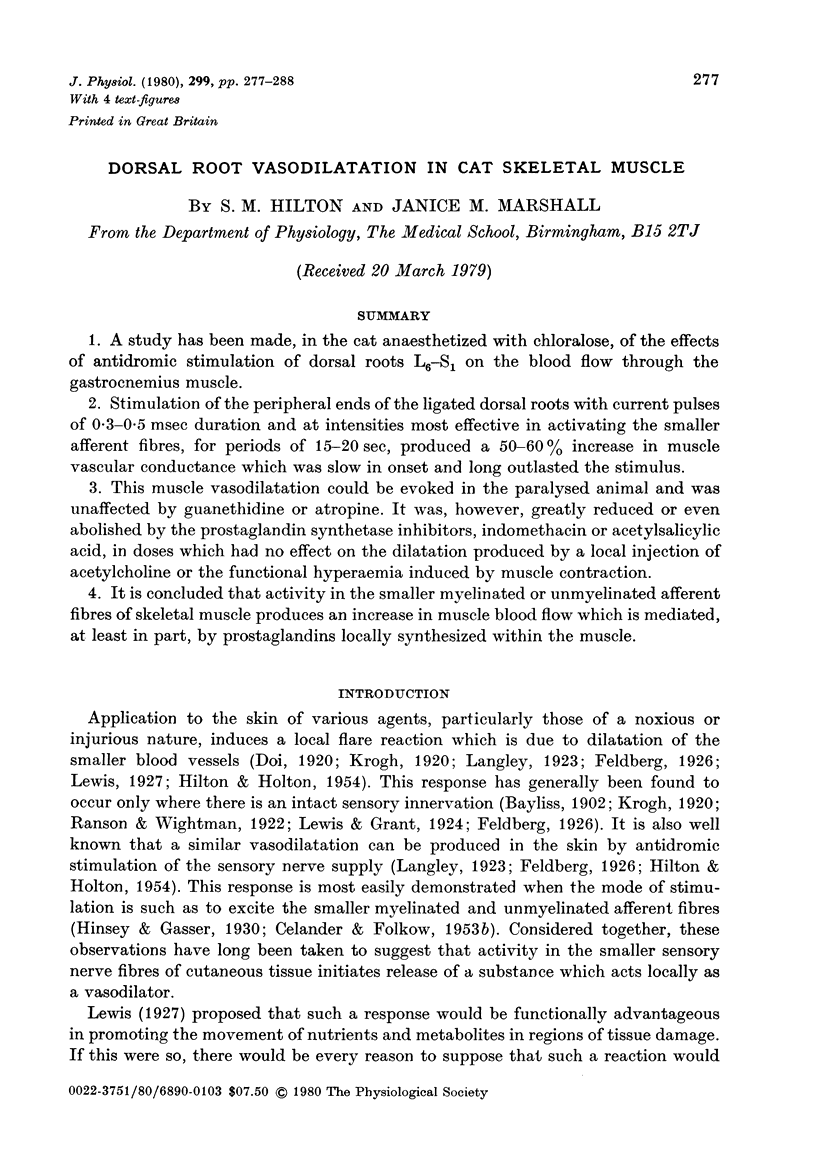
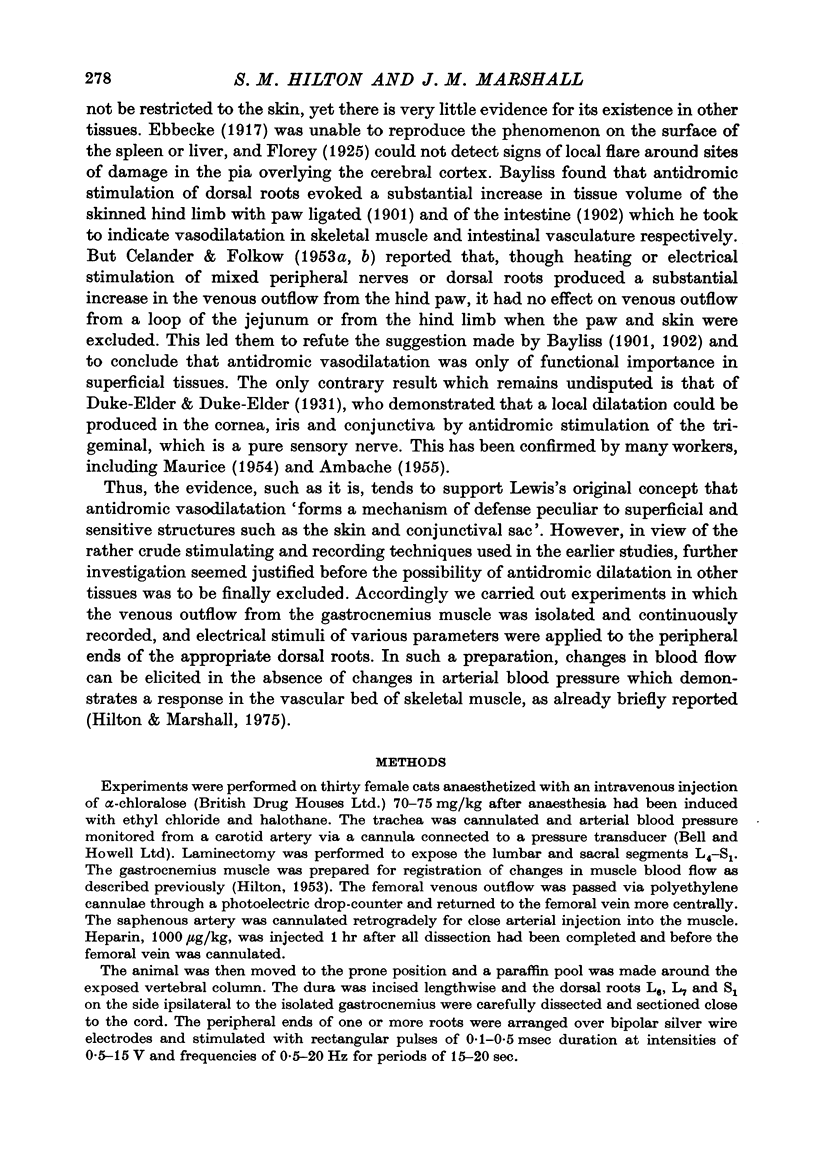
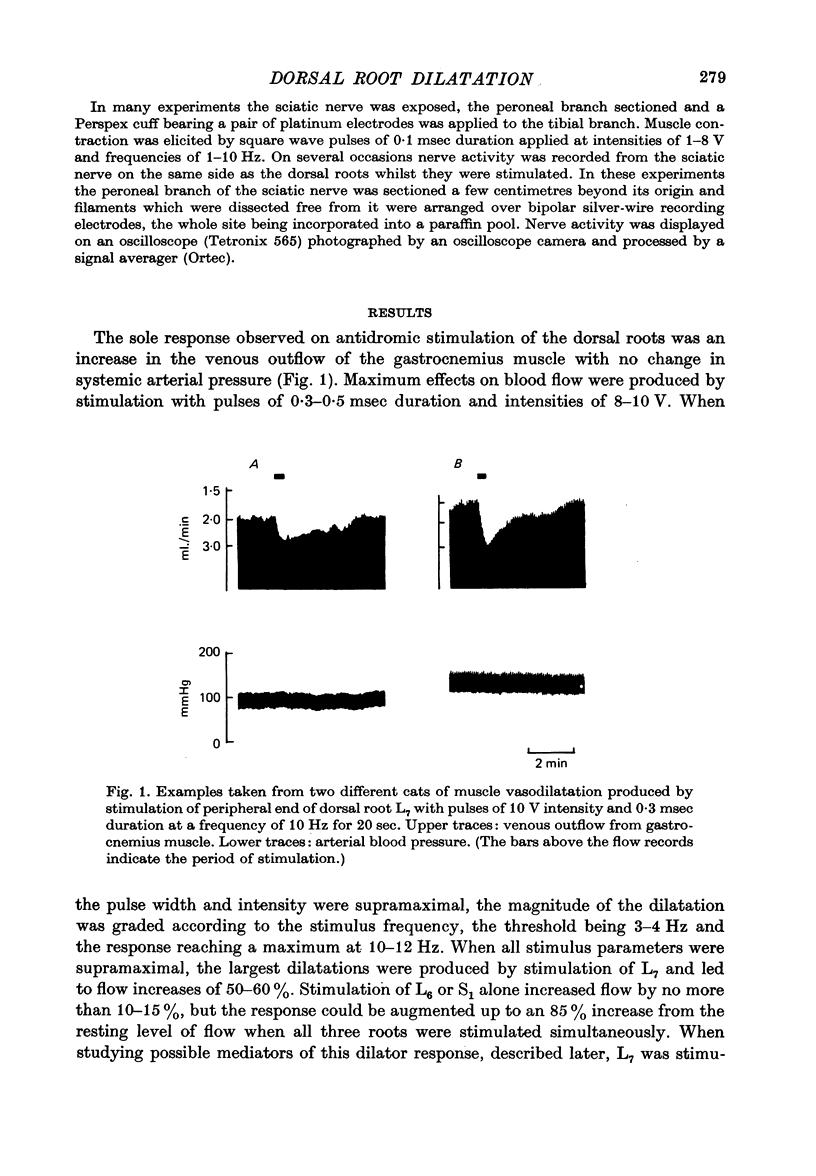
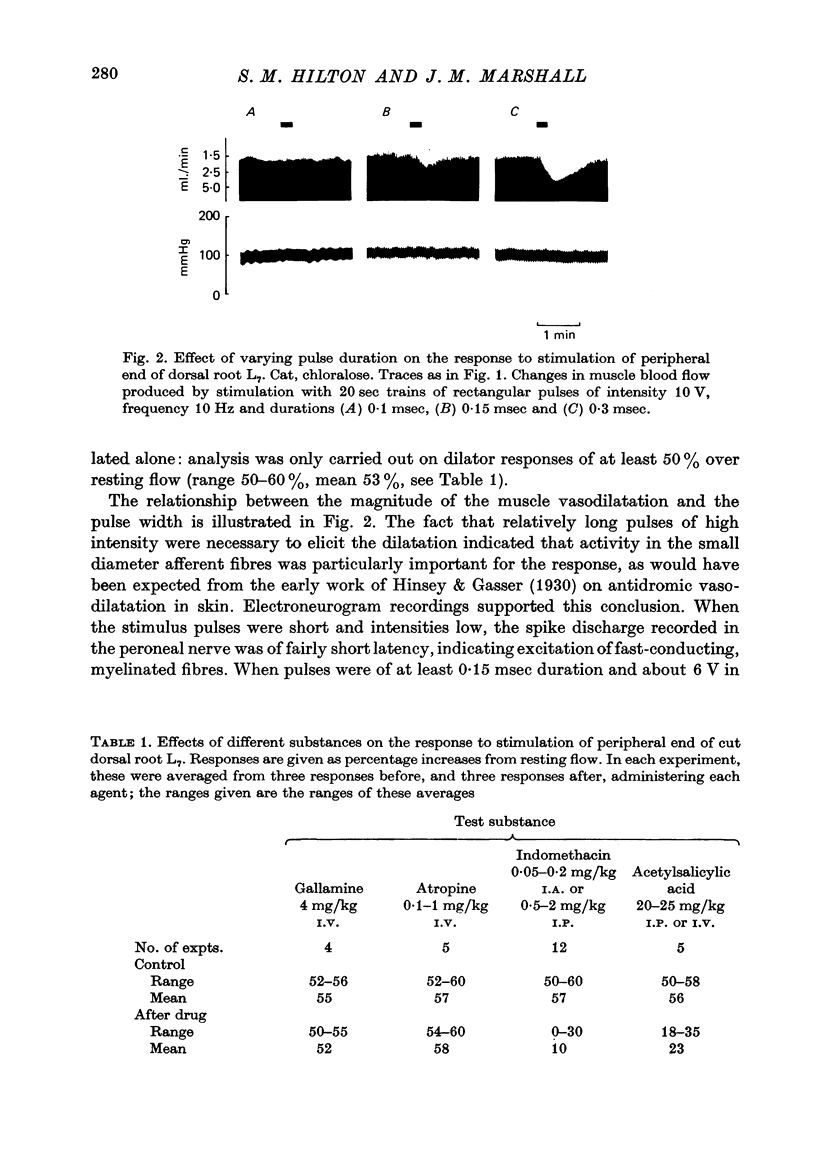
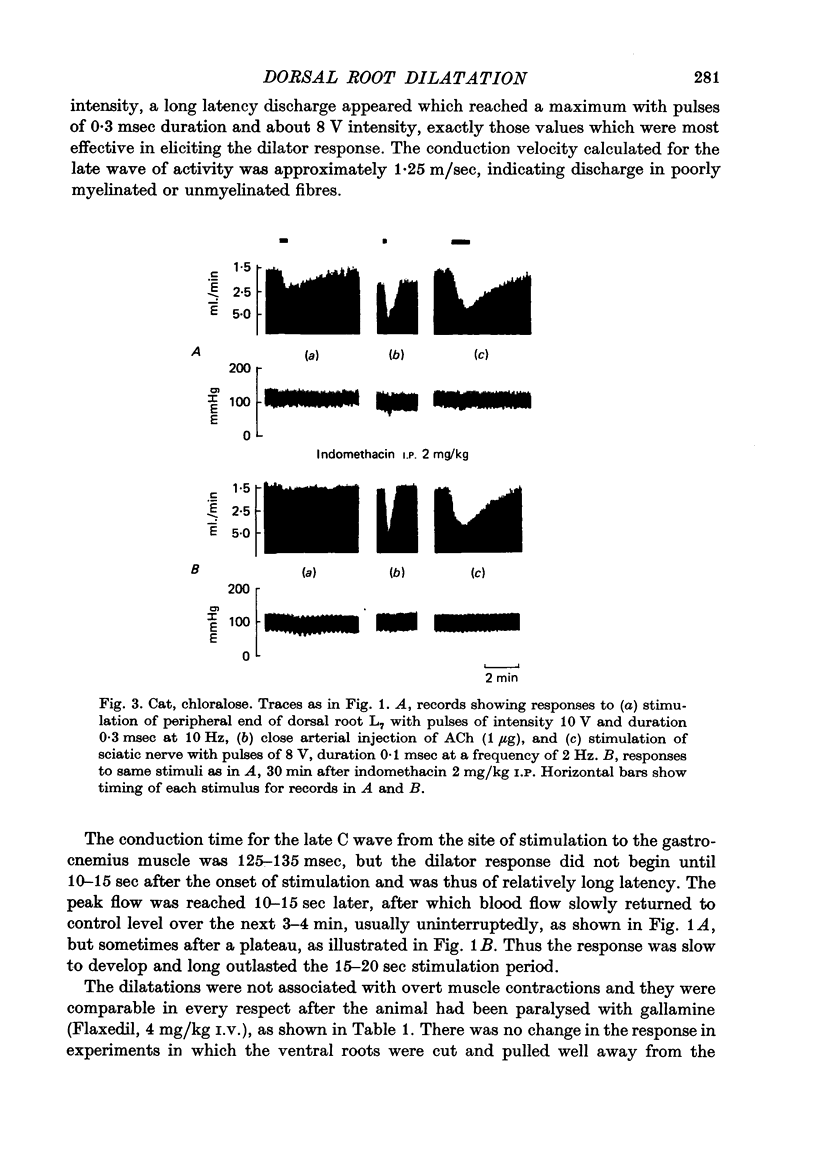
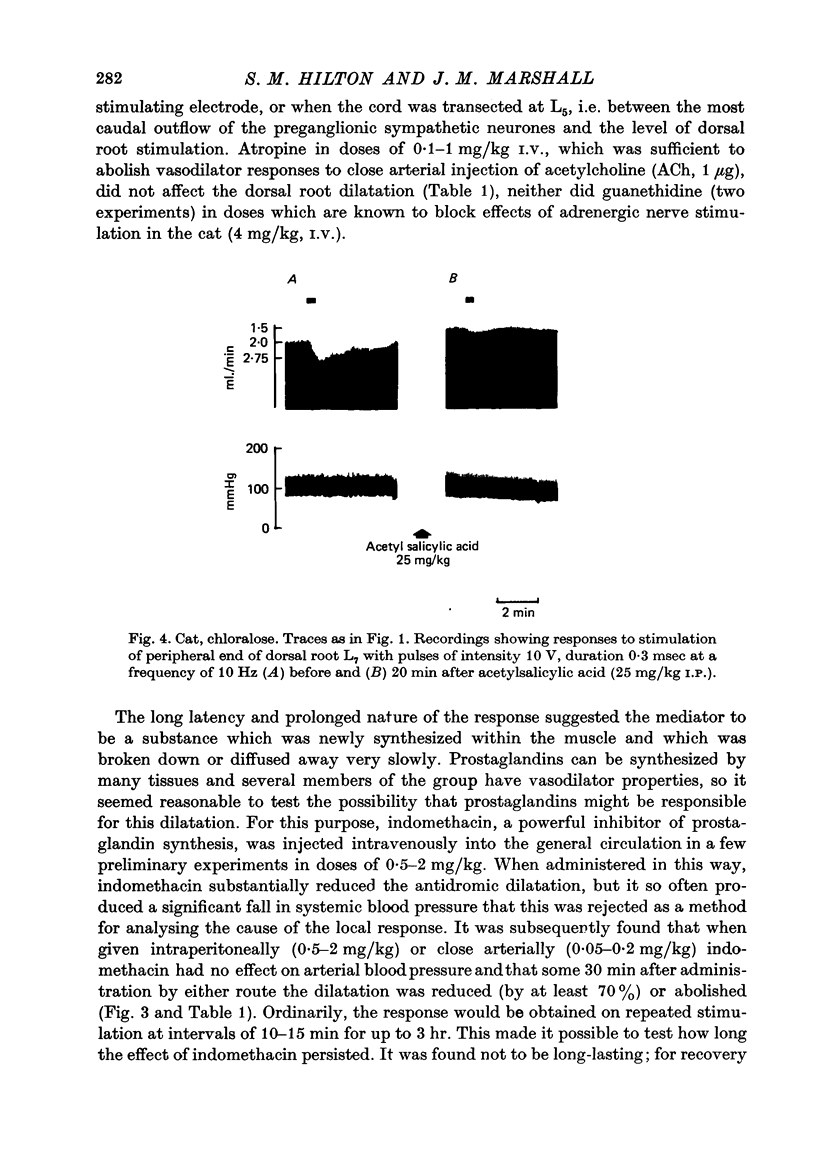
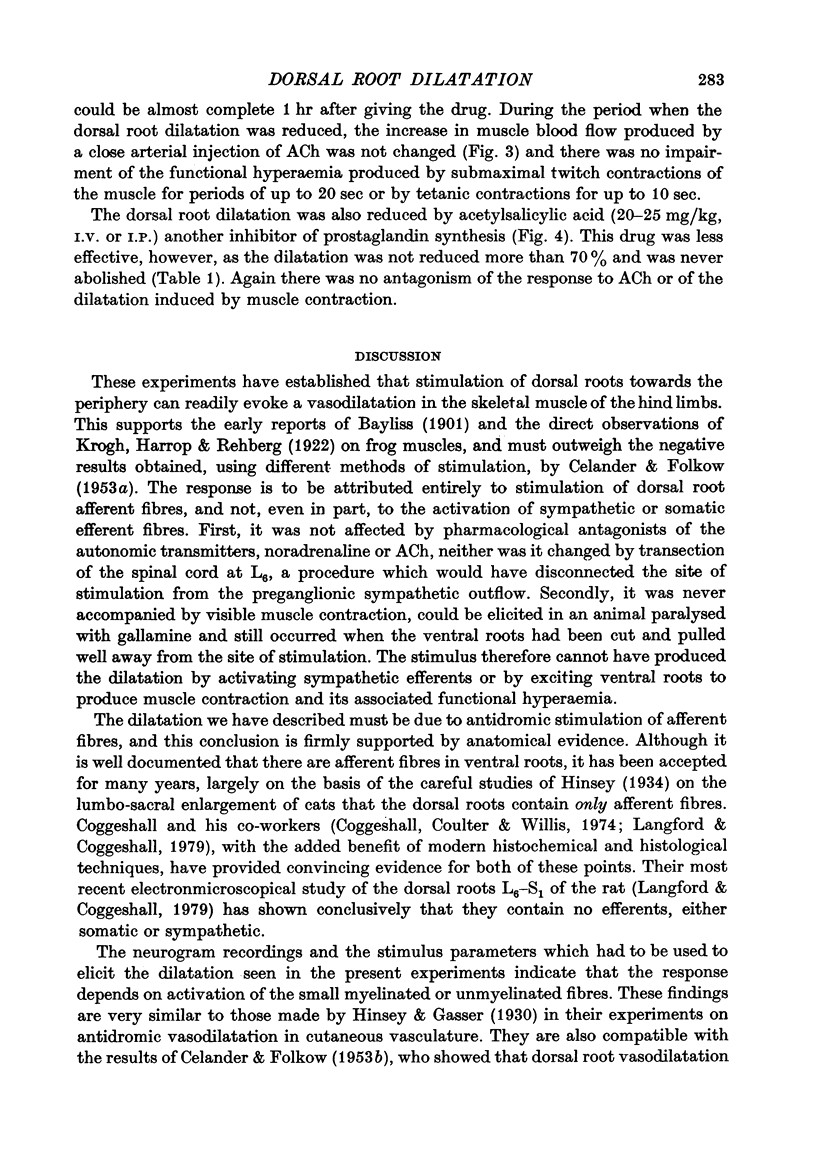
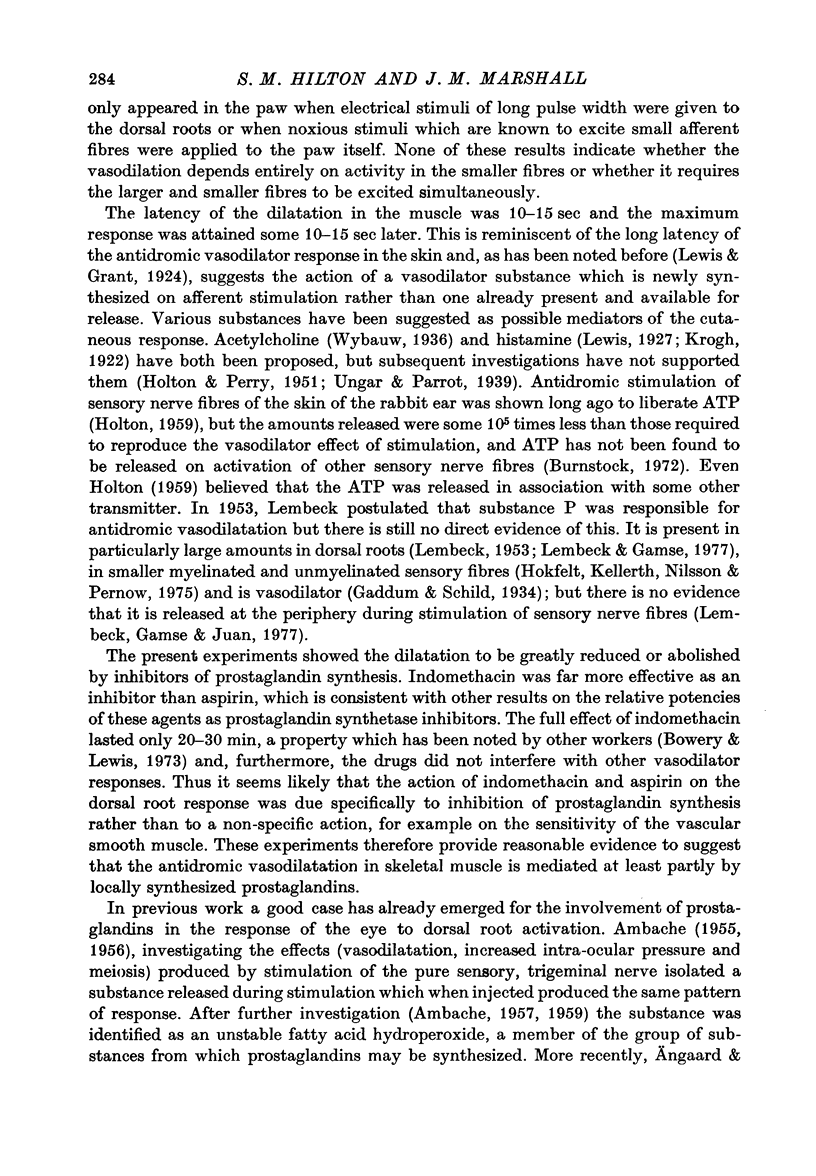
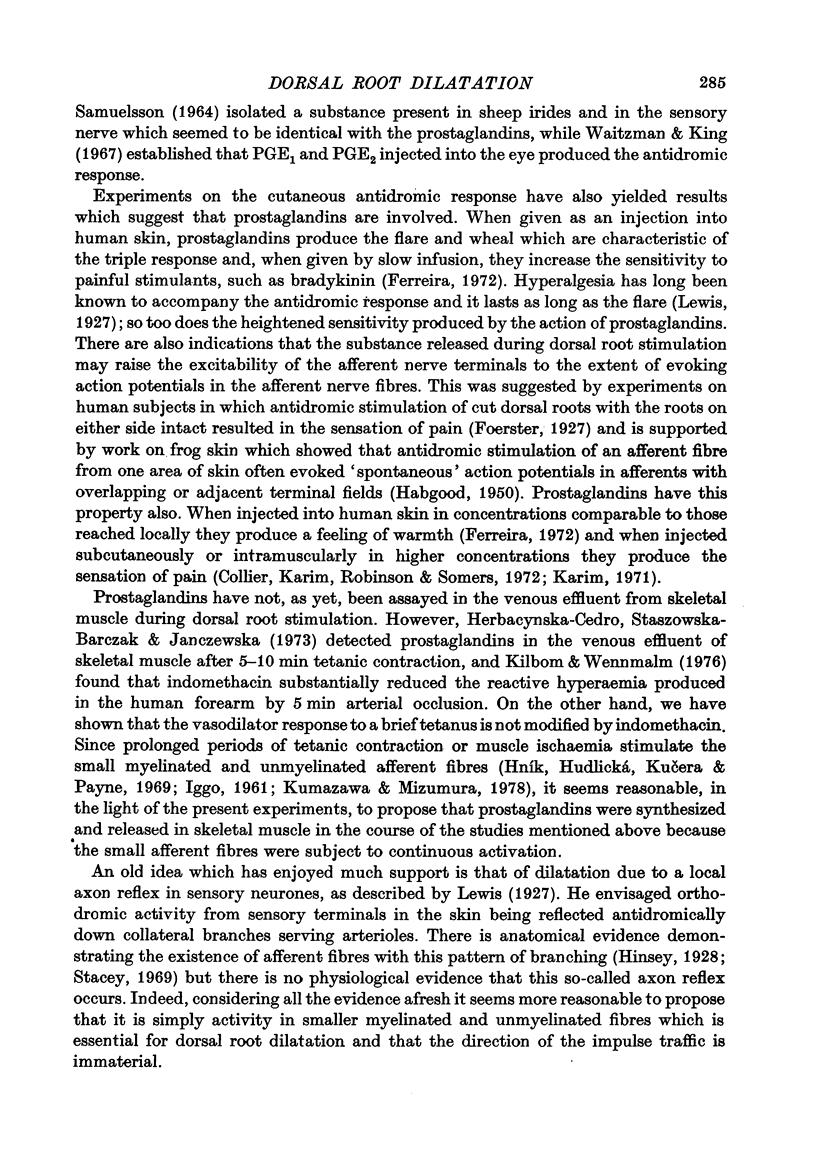
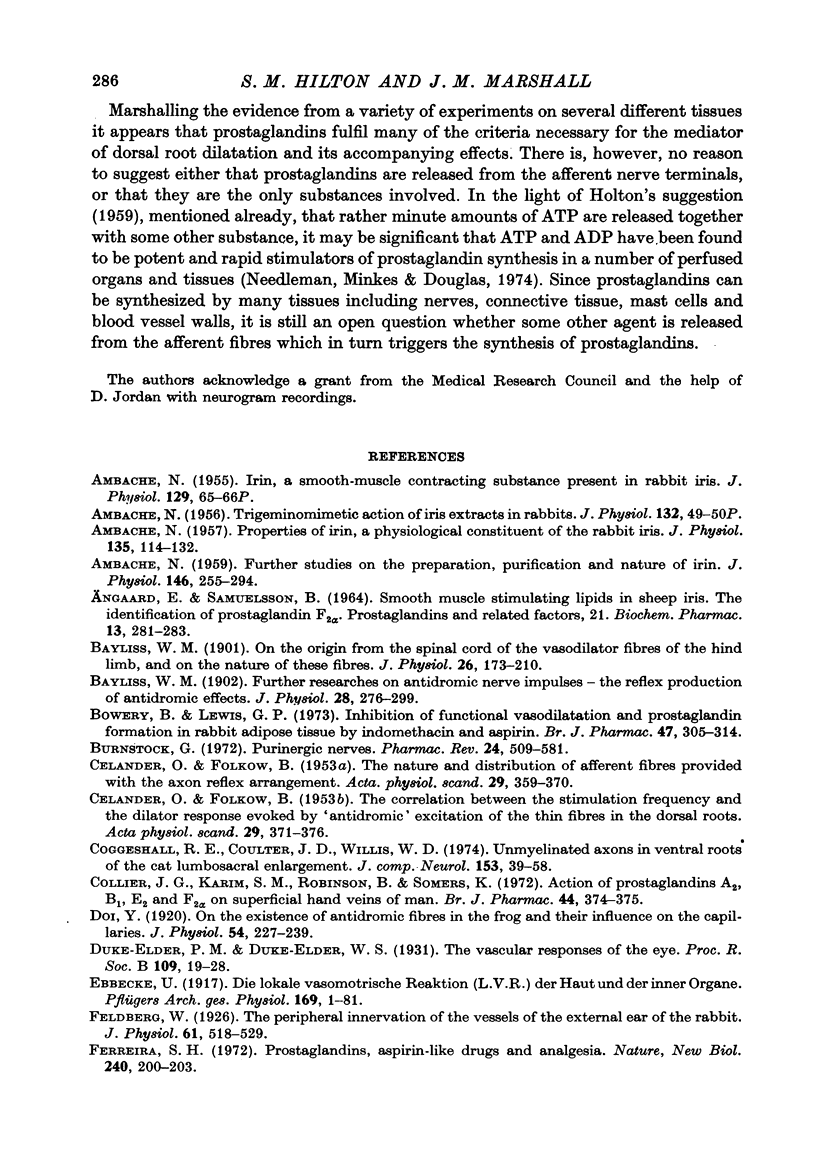
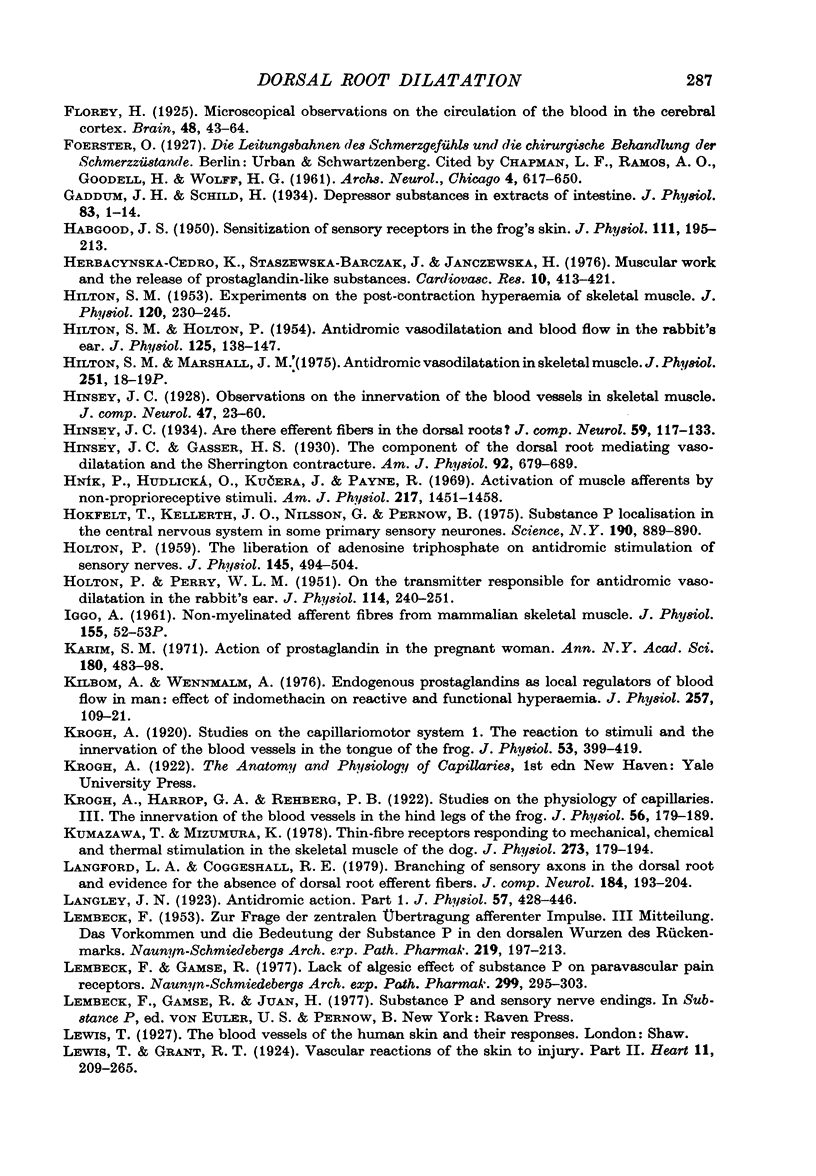
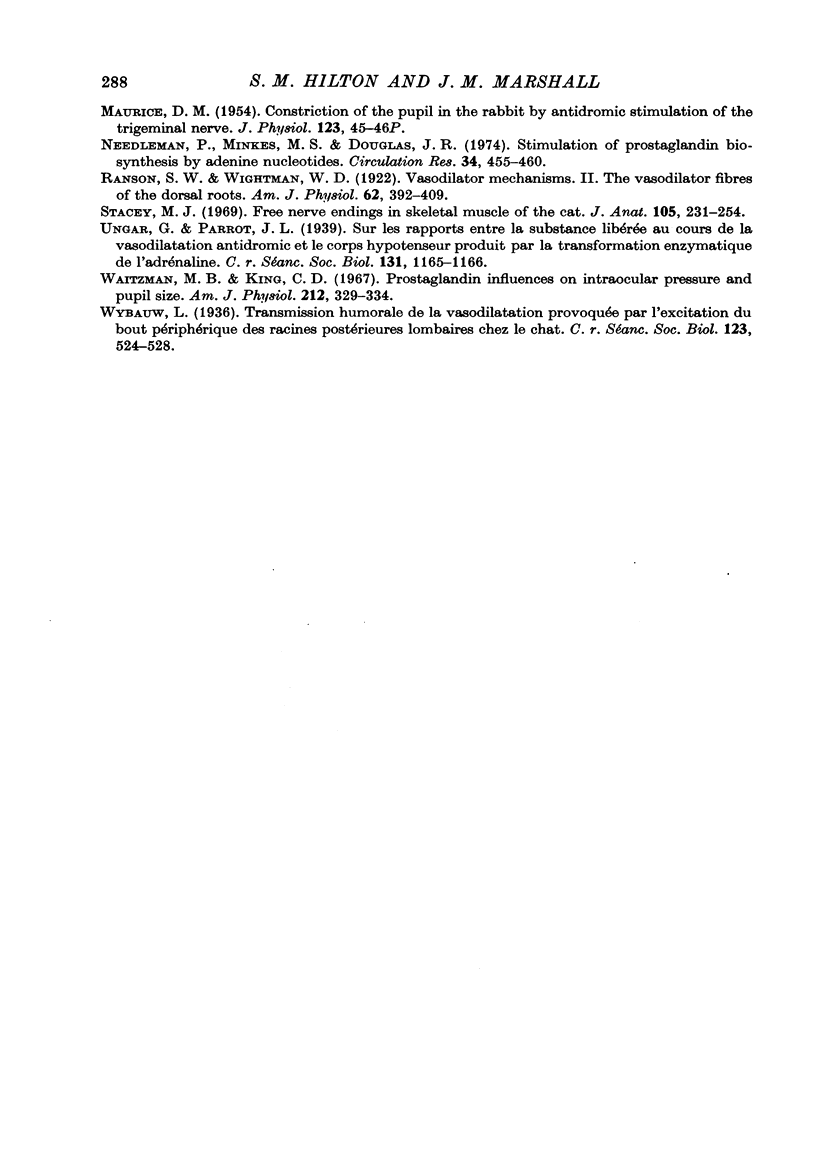
Selected References
These references are in PubMed. This may not be the complete list of references from this article.
- AMBACHE N. Further studies on the preparation, purification and nature of irin. J Physiol. 1959 May 19;146(2):255–294. doi: 10.1113/jphysiol.1959.sp006193. [DOI] [PMC free article] [PubMed] [Google Scholar]
- AMBACHE N. Properties of irin, a physiological constituent of the rabbit's iris. J Physiol. 1957 Jan 23;135(1):114–132. doi: 10.1113/jphysiol.1957.sp005699. [DOI] [PMC free article] [PubMed] [Google Scholar]
- AMBACHE N. Trigeminomimetic action of iris extracts in rabbits. J Physiol. 1956 May 28;132(2):49–50P. [PubMed] [Google Scholar]
- ANGGARD E., SAMUELSSON B. SMOOTH MUSCLE STIMULATING LIPIDS IN SHEEP IRIS. THE IDENTIFICATION OF PROSTAGLANDIN F 2A. PROSTAGLANDINS AND RELATED FACTORS 21. Biochem Pharmacol. 1964 Feb;13:281–283. doi: 10.1016/0006-2952(64)90146-7. [DOI] [PubMed] [Google Scholar]
- Bayliss W. M. Further researches on antidromic nerve-impulses. J Physiol. 1902 Jul 21;28(4):276–299. doi: 10.1113/jphysiol.1902.sp000915. [DOI] [PMC free article] [PubMed] [Google Scholar]
- Bayliss W. M. On the origin from the spinal cord of the vaso-dilator fibres of the hind-limb, and on the nature of these fibres. J Physiol. 1901 Feb 28;26(3-4):173–209. doi: 10.1113/jphysiol.1901.sp000831. [DOI] [PMC free article] [PubMed] [Google Scholar]
- Bowery B., Lewis G. P. Inhibition of functional vasodilatation and prostaglandin formation in rabbit adipose tissue by indomethacin and aspirin. Br J Pharmacol. 1973 Feb;47(2):305–314. doi: 10.1111/j.1476-5381.1973.tb08328.x. [DOI] [PMC free article] [PubMed] [Google Scholar]
- Burnstock G. Purinergic nerves. Pharmacol Rev. 1972 Sep;24(3):509–581. [PubMed] [Google Scholar]
- CELANDER O., FOLKOW B. The correlation between the stimulation frequency and the dilator response evoked by 'antidromic' excitation of the thin afferent fibres in the dorsal roots. Acta Physiol Scand. 1953 Nov 17;29(4):371–376. doi: 10.1111/j.1748-1716.1953.tb01031.x. [DOI] [PubMed] [Google Scholar]
- CELANDER O., FOLKOW B. The nature and the distribution of afferent fibres provided with the axon reflex arrangement. Acta Physiol Scand. 1953 Nov 17;29(4):359–370. doi: 10.1111/j.1748-1716.1953.tb01032.x. [DOI] [PubMed] [Google Scholar]
- CHAPMAN L. F., RAMOS A. O., GOODELL H., WOLFF H. G. Neurohumoral features of afferent fibers in man. Their role in vasodilation, inflammation, and pain. Arch Neurol. 1961 Jun;4:617–650. doi: 10.1001/archneur.1961.00450120031005. [DOI] [PubMed] [Google Scholar]
- Coggeshall R. E., Coulter J. D., Willis W. D., Jr Unmyelinated axons in the ventral roots of the cat lumbosacral enlargement. J Comp Neurol. 1974 Jan 1;153(1):39–58. doi: 10.1002/cne.901530105. [DOI] [PubMed] [Google Scholar]
- Doi Y. On the existence of antidromic fibres in the frog and their influence on the capillaries. J Physiol. 1920 Dec 7;54(4):227–238. doi: 10.1113/jphysiol.1920.sp001922. [DOI] [PMC free article] [PubMed] [Google Scholar]
- Feldberg W. The peripheral innervation of the vessels of the external ear of the rabbit. J Physiol. 1926 Aug 6;61(4):518–529. doi: 10.1113/jphysiol.1926.sp002313. [DOI] [PMC free article] [PubMed] [Google Scholar]
- Ferreira S. H. Prostaglandins, aspirin-like drugs and analgesia. Nat New Biol. 1972 Dec 13;240(102):200–203. doi: 10.1038/newbio240200a0. [DOI] [PubMed] [Google Scholar]
- Gaddum J. H., Schild H. Depressor substances in extracts of intestine. J Physiol. 1934 Dec 14;83(1):1–14. doi: 10.1113/jphysiol.1934.sp003206. [DOI] [PMC free article] [PubMed] [Google Scholar]
- HILTON S. M. Experiments on the post contraction hyperaemia of skeletal muscle. J Physiol. 1953 Apr 28;120(1-2):230–245. doi: 10.1113/jphysiol.1953.sp004888. [DOI] [PMC free article] [PubMed] [Google Scholar]
- HILTON S. M., HOLTON P. Antidromic vasodilatation and blood flow in the rabbit's ear. J Physiol. 1954 Jul 28;125(1):138–147. doi: 10.1113/jphysiol.1954.sp005146. [DOI] [PMC free article] [PubMed] [Google Scholar]
- HOLTON P., PERRY W. L. M. On the transmitter responsible for antidromic vasodilatation in the rabbit's ear. J Physiol. 1951 Jun;114(1-2):240–251. doi: 10.1113/jphysiol.1951.sp004615. [DOI] [PMC free article] [PubMed] [Google Scholar]
- HOLTON P. The liberation of adenosine triphosphate on antidromic stimulation of sensory nerves. J Physiol. 1959 Mar 12;145(3):494–504. doi: 10.1113/jphysiol.1959.sp006157. [DOI] [PMC free article] [PubMed] [Google Scholar]
- Habgood J. S. Sensitization of sensory receptors in the frog's skin. J Physiol. 1950 Apr 15;111(1-2):195–213. doi: 10.1113/jphysiol.1950.sp004474. [DOI] [PMC free article] [PubMed] [Google Scholar]
- Herbaczynska-Cedro K., Staszewska-Barczak J., Janczewska H. Muscular work and the release of prostaglandin-like substances. Cardiovasc Res. 1976 Jul;10(4):413–420. doi: 10.1093/cvr/10.4.413. [DOI] [PubMed] [Google Scholar]
- Hník P., Hudlická O., Kucera J., Payne R. Activatioof muscle afferents by nonproprioceptive stimuli. Am J Physiol. 1969 Nov;217(5):1451–1457. doi: 10.1152/ajplegacy.1969.217.5.1451. [DOI] [PubMed] [Google Scholar]
- Hökfelt T., Kellerth J. O., Nilsson G., Pernow B. Substance p: localization in the central nervous system and in some primary sensory neurons. Science. 1975 Nov 28;190(4217):889–890. doi: 10.1126/science.242075. [DOI] [PubMed] [Google Scholar]
- Karim S. Action of prostaglandin in the pregnant woman. Ann N Y Acad Sci. 1971 Apr 30;180:483–498. doi: 10.1111/j.1749-6632.1971.tb53216.x. [DOI] [PubMed] [Google Scholar]
- Kilbom A., Wennmalm A. Endogenous prostaglandins as local regulators of blood flow in man: effect of indomethacin on reactive and functional hyperaemia. J Physiol. 1976 May;257(1):109–121. doi: 10.1113/jphysiol.1976.sp011358. [DOI] [PMC free article] [PubMed] [Google Scholar]
- Krogh A., Harrop G. A., Rehberg P. B. Studies on the physiology of capillaries: III. The innervation of the blood vessels in the hind legs of the frog. J Physiol. 1922 May 16;56(3-4):179–189. doi: 10.1113/jphysiol.1922.sp002000. [DOI] [PMC free article] [PubMed] [Google Scholar]
- Krogh A. Studies on the capillariometer mechanism: I. The reaction to stimuli and the innervation of the blood vessels in the tongue of the frog. J Physiol. 1920 May 18;53(6):399–419. doi: 10.1113/jphysiol.1920.sp001887. [DOI] [PMC free article] [PubMed] [Google Scholar]
- Kumazawa T., Mizumura K. Thin-fibre receptors responding to mechanical, chemical, and thermal stimulation in the skeletal muscle of the dog. J Physiol. 1977 Dec;273(1):179–194. doi: 10.1113/jphysiol.1977.sp012088. [DOI] [PMC free article] [PubMed] [Google Scholar]
- LEMBECK F. Zur Frage der zentralen Ubertragung afferenter Impulse. III. Das Vorkommen und die Bedeutung der Substanz P in den dorsalen Wurzeln des Rückenmarks. Naunyn Schmiedebergs Arch Exp Pathol Pharmakol. 1953;219(3):197–213. [PubMed] [Google Scholar]
- Langford L. A., Coggeshall R. E. Branching of sensory axons in the dorsal root and evidence for the absence of dorsal root efferent fibers. J Comp Neurol. 1979 Mar 1;184(1):193–204. doi: 10.1002/cne.901840111. [DOI] [PubMed] [Google Scholar]
- Langley J. N. Antidromic action: Part I. J Physiol. 1923 Aug 16;57(6):428–446. doi: 10.1113/jphysiol.1923.sp002081. [DOI] [PMC free article] [PubMed] [Google Scholar]
- Lembeck F., Gamse R. Lack of algesic effect of substance P on paravascular pain receptors. Naunyn Schmiedebergs Arch Pharmacol. 1977 Oct;299(3):295–303. doi: 10.1007/BF00500324. [DOI] [PubMed] [Google Scholar]
- MAURICE D. M. Constriction of the pupil in the rabbit by antidromic stimulation of the trigeminal nerve. J Physiol. 1954 Feb 26;123(2):45–6P. [PubMed] [Google Scholar]
- Needleman P., Minkes M. S., Douglas J. R., Jr Stimulation of prostaglandin biosynthesis by adenine nucleotides. Profile of prostaglandin release by perfused organs. Circ Res. 1974 Apr;34(4):455–460. doi: 10.1161/01.res.34.4.455. [DOI] [PubMed] [Google Scholar]
- Stacey M. J. Free nerve endings in skeletal muscle of the cat. J Anat. 1969 Sep;105(Pt 2):231–254. [PMC free article] [PubMed] [Google Scholar]
- Waitzman M. B., King C. D. Prostaglandin influences on intraocular pressure and pupil size. Am J Physiol. 1967 Feb;212(2):329–334. doi: 10.1152/ajplegacy.1967.212.2.329. [DOI] [PubMed] [Google Scholar]


